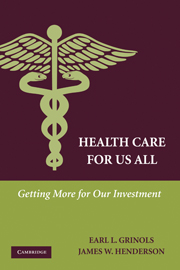Book contents
- Frontmatter
- Contents
- List of Tables
- List of Figures
- Preface
- Acknowledgments
- Executive Summary of the Targeted Intervention Plan
- PART I GOALS AND WORKING PRINCIPLES
- PART II BACKGROUND ECONOMICS AND ETHICS
- PART III APPLICATION
- PART IV PROTECTIVE MEASURES
- A Top Ten Goals for the American Health Care System
- B Badly Done Insurance Programs Can be Worse Than No Insurance
- C Incentive Symmetry and Intervention Principle
- D Plan Workability
- E Market Power Response to Insurance
- Glossary and Definitions
- References
- Index
D - Plan Workability
Published online by Cambridge University Press: 05 June 2012
- Frontmatter
- Contents
- List of Tables
- List of Figures
- Preface
- Acknowledgments
- Executive Summary of the Targeted Intervention Plan
- PART I GOALS AND WORKING PRINCIPLES
- PART II BACKGROUND ECONOMICS AND ETHICS
- PART III APPLICATION
- PART IV PROTECTIVE MEASURES
- A Top Ten Goals for the American Health Care System
- B Badly Done Insurance Programs Can be Worse Than No Insurance
- C Incentive Symmetry and Intervention Principle
- D Plan Workability
- E Market Power Response to Insurance
- Glossary and Definitions
- References
- Index
Summary
In April 2006, Baylor University graduate students traveled to Washington, D.C., in fulfillment of the final requirement of their M.B.A.-based project. There they presented their carefully researched plan for universal health coverage, crafted on principles comparable to those in this book. Their research used Medical Expenditure Panel Survey data (MEPS, the gold standard for U.S. medical expenditures data), other sources, and their own statistical input to “price-out” what a national plan might cost. Their independently worked proposal had features in common with the Massachusetts plan (Section 9.2), which was publicly announced the day before their own presentation in the Russell Senate Building (arranged by Texas senator Kay Bailey Hutchison's office) before an audience of representives of Washington think tanks, the Council of Economic Advisers, and senatorial staff.
This appendix reproduces abbreviated highlights, edited for length. Within the normal range of uncertainties, their numbers parallel those from careful work by others and provide confidence in plan feasibility. For example, Jack Hadley and John Holahan (2003) report that it would cost $33.9–$68.7 billion (2001 dollars) in additional medical care if the uninsured were insured, versus $47 billion here. Our editorial comments are appended at the end.
Data
The Medical Expenditure Panel Survey (MEPS) for 2003, compiled and edited by the Centers for Medicare and Medicaid Services (CMS) at the U.S. Department of Health and Human Services, served as our primary data source for personal care expenditures. All data used in the model of the plan were 2003 data. To ensure comparability, MEPS aggregate data were reconciled to 2003 Personal Care Expenditures provided by the National Health Expenditure Accounts (NHA) also compiled by the CMS.
- Type
- Chapter
- Information
- Health Care for Us AllGetting More for Our Investment, pp. 237 - 244Publisher: Cambridge University PressPrint publication year: 2009

